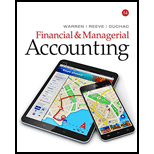
Continuing Company Analysis-Amazon: Short-term liquidity analysis
Amazon.com, Inc. is one of the largest Internet retailers in the world. Best Buy, Inc. is a leading retailer of consumer electronics and media products in the United States. Amazon and Best Buy compete in similar markets; however, Best Buy sells through both traditional retail stores and the Internet, while Amazon sells only through the Internet. Current asset and current liability information from recent financial statements are as follows (in millions):
| Amazon | Best Buy | |
| Current assets: | ||
| Cash | $14,557 | $ 2,432 |
| Short-term investments | 2,859 | 1,456 |
| 5,612 | 1,280 | |
| Inventories | 8,299 | 5,174 |
| Other current assets | — | 1,387 |
| Total current assets | $31,327 | $11,729 |
| Current liabilities: | ||
| Accounts payable | $16,459 | $ 5,122 |
| Other current liabilities | 11,630 | 2,314 |
| Total current liabilities | $28,089 | $ 7,436 |
A. Compute
B. Compute the
C. Compute the quick ratio for each company. (Round to one decimal place)
D. Can the working capital be usefully compared between the two companies? Explain.
E. Which company has the greater debt-paying ability according to the current ratio?
F. Which company has the greater short-term debt-paying ability according to the quick ratio?
G. Why are the results different between (E) and (F)? (Hint: Perform a vertical analysis of the current assets)
Trending nowThis is a popular solution!

Chapter 10 Solutions
Financial & Managerial Accounting
Additional Business Textbook Solutions
Financial Accounting, Student Value Edition (5th Edition)
Horngren's Accounting (12th Edition)
Marketing: An Introduction (13th Edition)
Horngren's Cost Accounting: A Managerial Emphasis (16th Edition)
Operations Management: Processes and Supply Chains (12th Edition) (What's New in Operations Management)
Gitman: Principl Manageri Finance_15 (15th Edition) (What's New in Finance)
- Computing and Interpreting Financial Statement RatiosFollowing are selected ratios of Norfolk Southern. Return on Assets (ROA) Component FY4 FY3 Profitability (Net income/Sales) 25.7% 27.0% Productivity (Sales/Average assets) 0.329 0.291 a. Was the company profitable in FY4? Answer 1b. In which year was the company more profitable? Answer 2c. Is the change in productivity a positive or negative development? Answer 3d. Compute the company’s ROA for both years. Note: Enter your answer as a percentage rounded to one decimal place (Ex: 29.4%).FY4 Answer 4%FY3 Answer 5%e. From the information, which of the following best explains the change in ROA during FY4?arrow_forwardExpand upon it and add to itarrow_forwardDefine these terms: A) Information Asymmetry. B) Material misstatement in the audited financial statements. C) The term "Professional Skepticism." D) Contribution margin ratio. E) Gross Margin, also known as Gross Profit Margin.arrow_forward
- No Ai Which of the following errors will cause the trial balance to not balance?A. Omission of a transactionB. Entry posted twiceC. Transposing digits in one sideD. Debiting one account and crediting anotherarrow_forwardDon't use ChatGPT!! Which of the following errors will cause the trial balance to not balance?A. Omission of a transactionB. Entry posted twiceC. Transposing digits in one sideD. Debiting one account and crediting anotherarrow_forwardWhich of the following is a temporary account?A. Retained EarningsB. Service RevenueC. Accounts PayableD. Inventoryarrow_forward
- Which of the following errors will cause the trial balance to not balance?A. Omission of a transactionB. Entry posted twiceC. Transposing digits in one sideD. Debiting one account and crediting anotherarrow_forwardMime Delivery Service is owned and operated by Pamela Kolp. The following selected transactionswere completed by Mime Delivery Service during October:1. Received cash from the owner as an additional investment, $7,500.2. Paid creditors on account, $815.3. Billed customers for delivery services on account, $3,250.4. Received cash from customers on account, $1,150.5. Paid cash to the owner for personal use, $500.Required:Indicate the effect of each transaction on the accounting equation elements (Assets, Liabilities,Owner’s Equity, Drawing, Revenue, and Expense) by listing the numbers identifying the transactions,(1) to (5). Also, indicate the specific item within the accounting equation element that is affected, i.e.(1) Asset (Cash) increases by $; Owner’s Equity (Pamela Kolp, Capital) increases by $.arrow_forwardWhen a company incurs an expense but does not yet pay it, what is the entry?A. Debit Expense, Credit CashB. Debit Liability, Credit ExpenseC. Debit Expense, Credit LiabilityD. No entry needed helparrow_forward
- When a company incurs an expense but does not yet pay it, what is the entry?A. Debit Expense, Credit CashB. Debit Liability, Credit ExpenseC. Debit Expense, Credit LiabilityD. No entry neededarrow_forwardDont use ai What is the effect of writing off an uncollectible account under the allowance method?A. Increases net incomeB. No effect on total assetsC. Decreases revenueD. Increases expensesarrow_forwardWhat is the effect of writing off an uncollectible account under the allowance method?A. Increases net incomeB. No effect on total assetsC. Decreases revenueD. Increases expensesi need help ..arrow_forward
 Cornerstones of Financial AccountingAccountingISBN:9781337690881Author:Jay Rich, Jeff JonesPublisher:Cengage Learning
Cornerstones of Financial AccountingAccountingISBN:9781337690881Author:Jay Rich, Jeff JonesPublisher:Cengage Learning Financial Accounting: The Impact on Decision Make...AccountingISBN:9781305654174Author:Gary A. Porter, Curtis L. NortonPublisher:Cengage Learning
Financial Accounting: The Impact on Decision Make...AccountingISBN:9781305654174Author:Gary A. Porter, Curtis L. NortonPublisher:Cengage Learning Financial AccountingAccountingISBN:9781337272124Author:Carl Warren, James M. Reeve, Jonathan DuchacPublisher:Cengage Learning
Financial AccountingAccountingISBN:9781337272124Author:Carl Warren, James M. Reeve, Jonathan DuchacPublisher:Cengage Learning EBK CONTEMPORARY FINANCIAL MANAGEMENTFinanceISBN:9781337514835Author:MOYERPublisher:CENGAGE LEARNING - CONSIGNMENT
EBK CONTEMPORARY FINANCIAL MANAGEMENTFinanceISBN:9781337514835Author:MOYERPublisher:CENGAGE LEARNING - CONSIGNMENT





